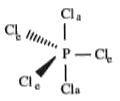PCl5 in solid state exists as PCl+4andPCl−6 and also in some solvents it undergoes dissociation as 2PCl5⇔PCl+4+PCl−6
Which statement is wrong ? Solution in Telugu
In PCl5 all the P - Cl bonds are of same enery
PCl5 has no lone pair of electrons
PCl5 is a white solid wich melts at 1670C
PCl5 gives white fumes with moist air
The correct Answer is:A
PCl5−Sp3d - trigonal bipyramidal geometry

P−Cla=P−Cle
- yellowish white powder
- Gives white forms in moist air because of liberation of HCl.
PCl5+4H2O→H3PO4+5HCl→ white fumes
Similar Questions
In the soild state , PCl5 exists in the lonic form as [PCl4]+[PCl6]−. What are the shapes of these two ions ? Why ?
View SolutionWhy does PCl5 exist as [PCl4]+[PCl6]− in the crystalline state?
View SolutionIn solid state \(PCl_{5}\) exists as ionic solid \([PCl_{4}]^{+}\)[\(PCl_{6}^{-}\)] ,in which \([PCl_{4}]^{+}\)is the cation and \(PCl_{6}^{-}\) is the anion.The geometry of cation and anion respectively are
View SolutionIn solid state, PCl5 is known to exists as [PCl4]+[PCl6]−
View SolutionPCl_(5)+Cl^(-) to PCl_(6)^(-) . The wrong statement regarding the above equation is
View SolutionPCl_(5) in solid state exists as PCl_(4)^(+) and PCl_(6)^(-) and also in some solvents it undergoes dissociation as 2PCl_(5) hArr PCl_(4)^(+) +PCl_(6)^(-) The geometry and hydridisation of PCl_(4)^(+) is
View SolutionPCl_(5) in solid state exists as PCl_(4)^(+) and PCl_(6)^(-) and also in some solvents it undergoes dissociation as 2PCl_(5) hArr PCl_(4)^(+) +PCl_(6)^(-) The geometry and hybridisation of PCl_(6)^(-) is
View Solution
